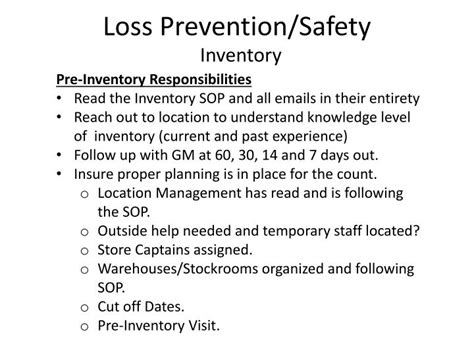In today’s fiercely competitive retail landscape, loss prevention has become an indispensable function for businesses seeking to protect their profits and maintain customer trust. Loss prevention officers play a crucial role in safeguarding assets, mitigating risks, and enhancing the overall safety of retail establishments.

Understanding Loss Prevention Duties
Loss prevention officers assume a wide array of essential duties, including:
-
Preventing Inventory Shrinkage: Loss prevention officers implement strategies to minimize shrink, the loss of inventory due to theft, damage, or administrative errors. They utilize various techniques such as surveillance systems, door greeters, and anti-theft devices to deter and detect suspicious activities.
-
Investigating Incidents: When inventory discrepancies or suspicious activities occur, loss prevention officers conduct thorough investigations. They gather evidence, interview witnesses, and collaborate with law enforcement to identify and apprehend perpetrators.
-
Enhancing Store Security: Loss prevention officers assess security vulnerabilities and recommend measures to improve store safety. They implement access control systems, maintain surveillance cameras, and train employees on security protocols.
-
Employee Training and Awareness: Loss prevention officers educate employees about loss prevention best practices. They conduct training sessions on recognizing suspicious behavior, responding to theft attempts, and preventing inventory shrinkage.
-
Customer Service and Engagement: Loss prevention officers interact with customers in a professional and courteous manner. They build relationships with regular patrons and address any concerns related to safety or security.
Quantifying the Impact of Loss Prevention
According to the National Retail Federation (NRF), retail shrink reached $94.5 billion in 2021, representing 1.38% of total retail sales. This staggering figure underscores the importance of effective loss prevention measures.
Responsibilities of Loss Prevention Officers
To effectively fulfill their duties, loss prevention officers must possess the following skills and qualifications:
- Strong interpersonal and communication skills
- Excellent observational and investigative abilities
- Knowledge of security systems and technologies
- Understanding of retail operations and customer behavior
- Ability to work independently and as part of a team
Loss Prevention Strategies
Loss prevention officers employ a combination of physical, technological, and procedural strategies to reduce shrink. These include:
-
Physical Security: Implementing door greeters, installing surveillance cameras, and securing inventory with anti-theft devices.
-
Technological Solutions: Utilizing electronic article surveillance (EAS) systems, point-of-sale (POS) monitoring software, and facial recognition technology.
-
Procedural Measures: Training employees on loss prevention protocols, conducting regular audits, and implementing vendor management programs.
Emerging Applications of Loss Prevention
Loss prevention technology continues to evolve, opening up new possibilities for businesses to enhance their security measures. One emerging application is predictive analytics, which uses data analysis to identify patterns and predict potential loss events. By anticipating and mitigating risks proactively, businesses can further reduce their vulnerability to theft and fraud.
Tables for Data Analysis
| Loss Prevention Strategies | Effectiveness | Cost | Implementation Time |
|---|---|---|---|
| Door Greeters | Moderate | Low | Short |
| Surveillance Cameras | High | Medium | Medium |
| Electronic Article Surveillance (EAS) | High | High | Medium |
| Point-of-Sale (POS) Monitoring | Moderate | Low | Short |
| Types of Retail Shrink | Percentage of Total Shrink |
|---|---|
| Theft | 40.2% |
| Administrative Errors | 28.2% |
| Vendor Fraud | 12.3% |
| Damage | 10.6% |
| Other | 8.7% |
| Best Practices for Loss Prevention |
|---|
| Implement a layered security approach |
| Train employees on loss prevention protocols |
| Conduct regular audits |
| Stay abreast of emerging loss prevention technologies |
| Foster a culture of accountability |
Questions for Customer Engagement
- What are your concerns regarding theft or security in your favorite stores?
- What measures do you think businesses can take to enhance loss prevention?
- How do you feel about the use of technology in loss prevention efforts?
By actively engaging customers and understanding their perspectives, businesses can tailor their loss prevention strategies to meet their evolving needs.
